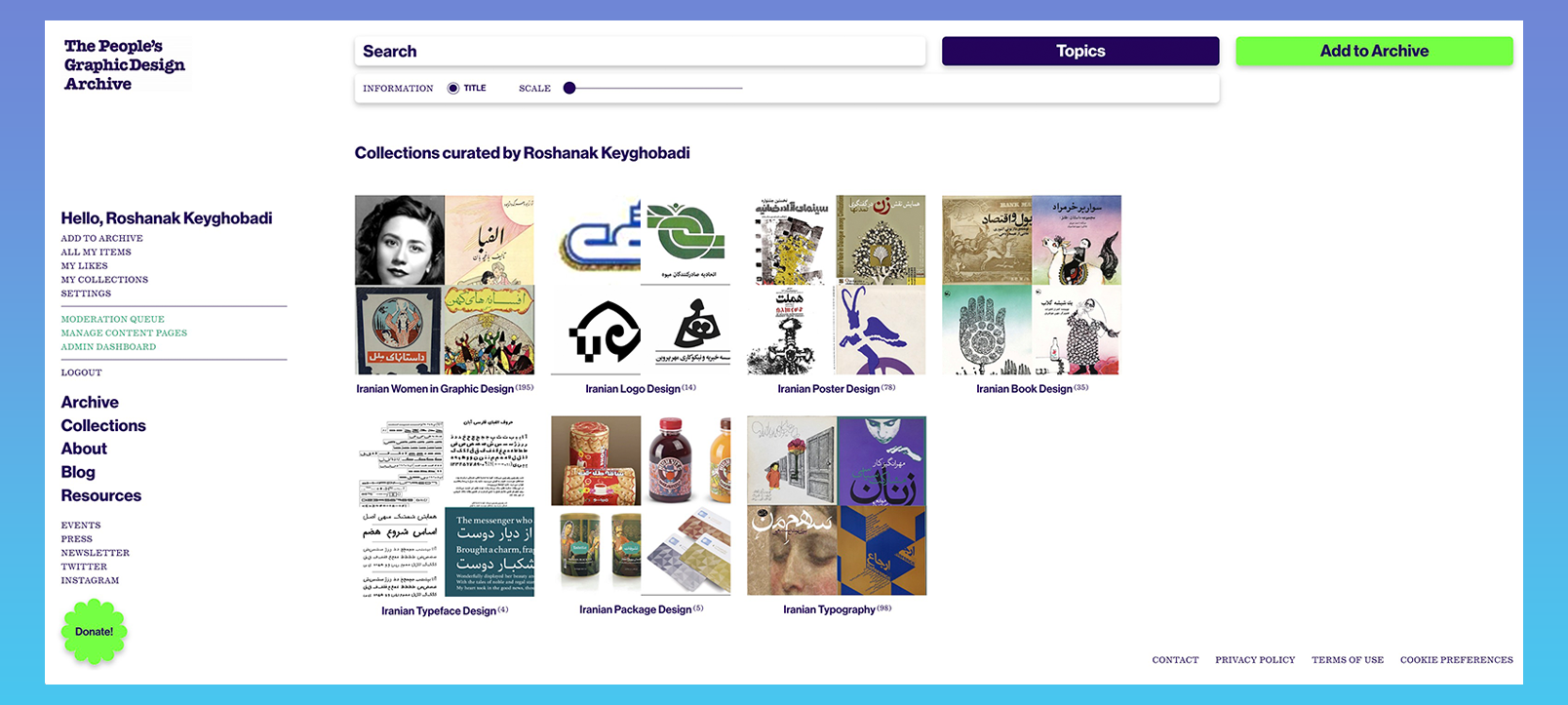Featured Contributor — Roshanak Keyghobadi

Iranian Design collections assembled by Roshanak
PGDA: You recently added hundreds of items to PGDA representing Iranian graphic design history—particularly Iranian women. How did this project begin for you?
Roshanak: Two events sparked the idea for this project. One was the publication of a book in Iran titled: One Hundred Years of Graphic Design in Tehran, 2020, which named 100 Iranian graphic designers and only included 6 women designers in the list. The other was an invitation from Khatt Foundation’s director Dr. Huda AbiFares to give a presentation on Iranian women graphic designers in diaspora at Revealing, Recording, Reflecting: Women Graphic Designers From Southwest Asia and North Africa, 2022 Conference in Berlin.
Both events directed my attention to the lack of historical documentation of Iranian women graphic designers’ works and names, therefore their faded presence in the historical accounts.
PGDA: What was your process in adding this much material?
Roshanak: As you mentioned, I had a very specific focus which was graphic design in Iran and particularly Iranian women graphic designers. As a graphic design scholar and researcher, I already knew about many of the women designers that did practice and also those who are active now. I started making a list by searching different resources such as professional directories and publications in Iran and abroad. Also, I searched online, looked at sites such as Instagram and Facebook (pages and groups), and also networking with other women designers.
Then I set up two rules for myself: Every entry should have the designer’s portrait (to make her face seen and known), and since this was an archival project, I looked for 3 samples of her works that were produced at least 10 years ago.
I gradually added 50 women designers to PGDA. For each entry, I began by uploading a portrait, then creating a title, adding more information in the “About” area, creating tags, and adding the related links and detailed information. All the information is not only in English but also in Persian in order to make it useful for Persian speaking scholars and students.
PGDA: One area that’s particularly valuable is the “About” section. How did you decide what to write in this area?
Roshanak: I decided that “About” section is the best place to add more in-depth information about the subject matter. At the present time I am adding more information for each designer and their work in this section to provide more historical, cultural, and visual context.
PGDA: You used our new Collections feature! How did that provide value for you?

Detail from Iranian Women in Graphic Design collection assembled by Roshanak
Roshanak: The “Collections” feature helped me categorize and organize the information better. I believe it is also helpful to users who are looking for a chain of related data.
PGDA: Is there any advice you’d give to others about adding large bodies of material?
Roshanak: People at first feel daunted dealing with a large body of material. My advice is to start with a focused topic. Before adding to the archive, collect and organize your information to correspond with PGDA data fields such as Title, Date, Contributors, and others. Keep track of your sources such as links and other information. Give yourself time to do your research.
PGDA: We hope others from communities that are traditionally not represented in graphic design will add to the Archive. What encouragement would you offer others?
Roshanak: PGDA is a safe space to share your research, exchange ideas and collaborate with others. It is a welcoming and open site for scholars, educators and students to contribute to the knowledge related to marginalized histories of graphic design.
What I really like when submitting data to PGDA is the “File Source” field which requires a link to the original source of images before publishing any entries. This guarantees credit will be given where credit is due. As a researcher I appreciate this feature and encourage everyone to always cite their sources and respect other researchers’ works.
I started my collaboration with PGDA because I needed a platform not only to share my ongoing investigations, network with other designers, collaborate with like-minded researchers and educators but also to create a reliable source for weaving back missing threads in the tapestry of global histories of graphic design. I hope anyone who is interested in the history of graphic design in Iran will contact and join me to add to what I have started on PGDA, and this would mark the beginning of many collaborations.
I would also like to thank Louise Sandhaus, Briar Levit, Brockett Horne and the team behind the archive for their help and support.
Roshanak is Assistant Professor of Visual Communications at Farmingdale State College - SUNY